
Demand Model Methodology
Assessing Affordable Housing Need
One of the challenges for affordable housing advocates is quantifying the need for affordable housing and setting concrete goals for housing policy and programs. We hope our efforts here can inform policy that supports and incentivizes the specific kinds of housing development that will meet our community’s needs
The purpose of an affordable housing demand model is to quantitatively estimate the number of housing units needed to produce affordable housing for the entire population of a geographic area. It takes into account existing housing supply and estimates current affordable housing demand in order to calculate unmet affordable housing demand.
Because different households have different needs based on their household income and the size of their household, it is important to be able to disaggregate demand by housing cost and the number of bedrooms. This model is designed to be replicable by housing advocacy groups, government agencies, and for-profit and non-profit housing developers both here in St. Louis region and in other communities from across the country.
Building a Demand Model
Geography
Our housing demand model includes St. Louis City and Saint Louis County, which includes 88 separate municipalities and 10 unincorporated areas.
Timeframe
Our affordable housing model is designed to estimate current affordable housing needs. In order to amend this model to predict future demand, changes in affordable housing demand and supply must be estimated. Changes in demand are based on the rate of change in population. Changes in supply are based on the rate of change in new construction and the rate of change in property obsolescence (ex. demolitions, multi-unit to single-unit conversions).
Stakeholder Engagement
The St. Louis affordable housing community includes policymakers, incentive program managers, housing developers, and tenant advocates. For the demand model, URBNRX held several meetings with members of the Affordable Housing Trust Fund Coalition and representatives from St. Louis City and County government.
Precedent
The St. Louis Affordable Housing Demand Model was inspired by the affordable housing demand model developed by HousingNOLA for New Orleans. This model was initially shared in the HousingNOLA 10 Year Strategy and Implementation Plan for a More Equitable New Orleans.
Data
The key factors to estimating unmet demand are (1) households, by income and tenure, and (2) housing units, by monthly cost and bedroom type. We will walk you through how each data set is used and whether it is used to build data-based assumptions.
The St. Louis Affordable Housing Demand Model uses the following data sources:
ACS 2015-2019 5-year estimates
2013-2017 CHAS data from HUD
Special Tabulations data from HUD
2010 Census
As there is not a single data set available that perfectly aligns with our need to estimate the number of bedrooms needed at different affordability levels, we developed a set of assumptions based on data that was available on households and families. Each table shows estimated counts of households. There will be some variation in the total household count based on the data set used. Even with these variations, we are confident in the demand that is shown. Definitive counts are available from the Census Bureau on a ten-year basis.
Defining Affordability
We use the U.S. Department of Housing and Urban Development’s (HUD) definition of “affordable.” For renters, affordability means paying less than 30% of their income on housing, including rental and utility payments. For homeowners, affordability means paying less than 30% of their income on mortgage, utility, property taxes, and insurance payments. HUD uses Area Median Income (AMI) categories to provide a baseline definition of household income to support their housing policy and analysis.
Data Source: HUD’s Comprehensive Housing Affordability Strategy (CHAS), 2020
There are 542,000 households in the St. Louis City and County region. Of these households, 78,550 households or 14.5% are in the lowest income group of 0-30% median family income (MFI). 27% of renter households are in the lowest income group, compared to 7% of homeowners. While 45% of all households make more than the median family income, the majority of these are homeowners.
While publicly available data do not break down housing units charging rent at exactly these prices, we align as closely as possible using the gross rent thresholds reported in the American Community Survey:
0-30% MFI: Affordable housing for families with incomes less than $22,400 costs less than $549 per month.
31-50% AMI: Affordable housing for families with incomes between $22,400 and $37,350 costs less than $999 per month.
51-80% AMI: Affordable housing for families with incomes between $37,350 and $59,700 costs less than $1,499 per month.
81-100% AMI: Affordable housing for families with incomes between $59,700 and $74,700 costs less than $1,999 per month.
These thresholds are nearly identical for homeowner housing costs as reported in the American Community Survey, with the exception of the lowest income bracket where we use the cost threshold of $599 instead of $549.
Assumptions
The St. Louis Affordable Housing Demand Model is predicated upon several assumptions, including the following:
The bedroom needs of similarly sized family types are the same, regardless of their household’s income.
The share of family types that make up each household size has not radically changed over the past 10 years.


